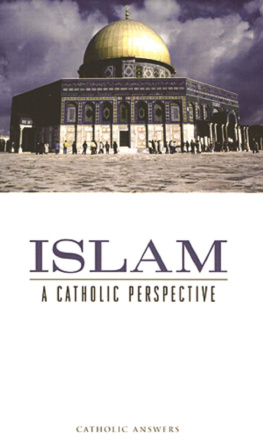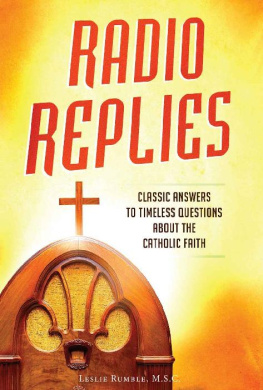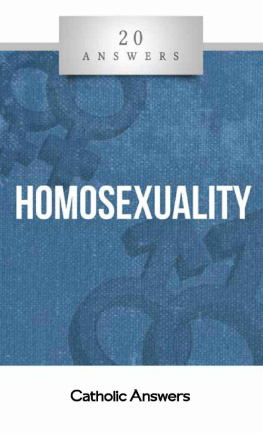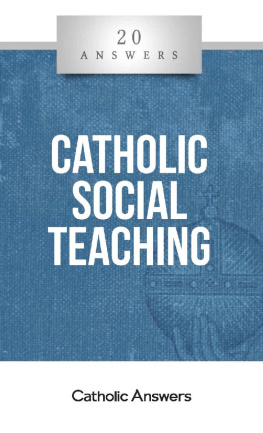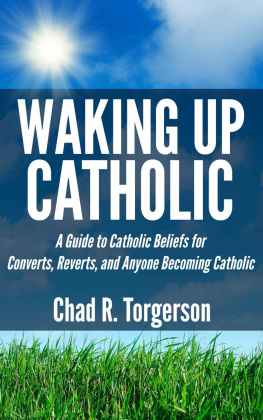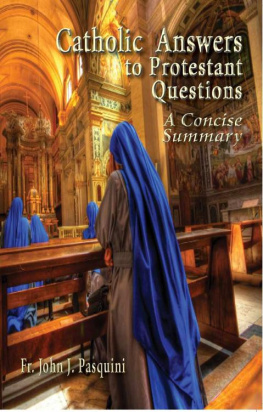Catholic Answers - Islam A Catholic Perspective
Here you can read online Catholic Answers - Islam A Catholic Perspective full text of the book (entire story) in english for free. Download pdf and epub, get meaning, cover and reviews about this ebook. year: 2013, publisher: Catholic Answers, genre: Religion. Description of the work, (preface) as well as reviews are available. Best literature library LitArk.com created for fans of good reading and offers a wide selection of genres:
Romance novel
Science fiction
Adventure
Detective
Science
History
Home and family
Prose
Art
Politics
Computer
Non-fiction
Religion
Business
Children
Humor
Choose a favorite category and find really read worthwhile books. Enjoy immersion in the world of imagination, feel the emotions of the characters or learn something new for yourself, make an fascinating discovery.
- Book:Islam A Catholic Perspective
- Author:
- Publisher:Catholic Answers
- Genre:
- Year:2013
- Rating:3 / 5
- Favourites:Add to favourites
- Your mark:
- 60
- 1
- 2
- 3
- 4
- 5
Islam A Catholic Perspective: summary, description and annotation
We offer to read an annotation, description, summary or preface (depends on what the author of the book "Islam A Catholic Perspective" wrote himself). If you haven't found the necessary information about the book — write in the comments, we will try to find it.
Islam A Catholic Perspective — read online for free the complete book (whole text) full work
Below is the text of the book, divided by pages. System saving the place of the last page read, allows you to conveniently read the book "Islam A Catholic Perspective" online for free, without having to search again every time where you left off. Put a bookmark, and you can go to the page where you finished reading at any time.
Font size:
Interval:
Bookmark:

Islam
A Catholic Perspective
Catholic
Answers
Press
San Diego
2003
Islam
A Catholic Perspective
2003 Catholic Answers
All rights reserved. Except for quotations, no part of this book may be reproduced or transmitted in any form or by any means, electronic or mechanical, including photocopying, recording, uploading to the Internet, or by any information storage and retrieval system, without written permission from the publisher.
Excerpts from the Bible taken from the Revised Standard Version: Catholic Edition (RSV:CE) unless otherwise noted.
Excerpts from the Quran (Q) taken from N. J. Dawood, tr., The Koran (London: Penguin Books, 1999) unless otherwise noted.
Note on Arabic Words
It is difficult to transliterate Arabic words into the English alphabet. This is because Arabic has a large number of sounds not used in English. Over the years, different transliteration methods have been employed. In general, we will use more contemporary spellings, as these tend to give a somewhat better sense of what the Arabic word sounds like. We will retain a few traditional spellings when a contemporary one would be hopelessly confusing (thus Mecca rather than Makkah ) or when the traditional usage is widespread (thus Mohammed rather than Muhammad ). Also to prevent confusion we standardize the spellings of Arabic words in quotations from other sources (thus Quran rather than Koran ).
Published by Catholic Answers
2020 Gillespie Way
El Cajon, California 92020
888-291-8000 orders
619-387-7200 contact
catholic.com
Cover Photography by IMS Communications Ltd.
Cover by Mary Lou Morreal
Interior by Russell Design
Printed in the United States of America
ISBN 978-1-938983-30-6
Introduction
In recent years, due to the increasing interconnectedness of the globe, as well as the rise of many Islamic militant and terrorist movements, Christians in the West have wished to learn more about Islam and how it should be regarded. Unfortunately, there are not many resources offering a distinctly Christian perspective on the subject, and many of those that are available are problematic.
Some texts err in portraying Islam in an overly negative light, as if it were the synthesis of all evil. Other texts, perhaps out of a desire to reassure the public or perhaps out of considerations of political correctness, err on the other side in portraying Islam in an overly positive light.
This text intends to offer a balanced approach, giving Islam credit for its good points but refusing to paper over its negative points. It will also provide a Christianand specifically a Catholicappraisal of Islam, as well as considering points that might be raised in discussions between Christians and Muslims.
I. The Basics
What is Islam?
Islam is the worlds second largest religion. It is thought to have as many as 1.2 billion members around the world, though this number may be somewhat inflated. Christianity, the worlds largest religion, is thought to have two billion members.
The name Islam is the Arabic word for submission and refers to the submission of the Muslim faithful to God and to his will.
What are adherents of Islam called?
The most common name for them is Muslims . The word muslim is Arabic for one who has submitted [i.e., to God]. An older English spelling of this word is Moslem .
Muslims should not be referred to as Mohammedans nor Islam as Mohammedanism . These words are considered offensive as they are taken to imply that Muslims worship Mohammed the way Christians worship Christ.
Who founded Islam?
Islam was founded by an Arabian man named Mohammed, the son of Abdullah. He was born in Mecca in what is now Saudi Arabia around the year A.D. 570. His family was well off, and his tribe served as the guardians of an ancient cubical shrine in Mecca known as the Kabah, which at the time was used for the worship of many different deities.
Mohammeds father died before he was born, and his mother died when he was young. He was raised by an uncle named Abu Talib, whose family was active in the caravan trading business. This brought Mohammed into contact with many peoples, including Jews and Christians, with whom he discussed religion.
Mohammed was employed to manage the caravan trading of a wealthy widow named Khadijah who was fifteen years older than he. Despite this, they married and had a number of children. Their only child to survive to adulthood was a daughter, Fatima.
After Khadijahs death, Mohammed began to practice polygamy and took other wives. Though in general Muslim men are allowed to take up to four wives, Mohammed took more than this (a precise count of how many is difficult to obtain). Among his more famous wives were Aisha, who was less than ten years old when he married her, and Zaynab, the former wife of Mohammeds adopted son, Zayd. (When Zayd saw that Mohammed desired Zaynab, he divorced her to make way for his adopted father to have her, a union that God supposedly endorsed in a revelation to Mohammed.)
Mohammed died in 632, following a tumultuous, twenty-three year prophetic career.
How did Islam start?
Mohammed was accustomed to meditate in a cave on Mount Hirah, just outside Mecca. In the month of Rammadan of 610, when Mohammed was around forty, he claimed to hear a voice (of God or the Angel Gabriel) that gave him the first of many reported revelations that were later collected together in the Muslim holy book, the Quran (Arabic, reading or recitation ). He then began preaching to the people of his native city what he claimed God was revealing to him.
At the time, the tribes of Arabia contained a mixture of different religions including large numbers of Christians, Jews, and pagans. The tribe of Mohammeds birth (the Quraysh) was predominantly pagan and protected the Kabah shrine in Mecca. Many of the Christians in Arabia were not orthodox in their faith, and so Mohammeds principal exposure to Christianity included heretical presentations of Christian doctrine, such as that of the Jacobite Christians, a group of Syrian Christians adhering to the monophysite heresy.
The reaction to Mohammeds early preaching was not enthusiastic. At first he made converts of only his wife, his nephew, and his adopted son, Zayd (a former slave that Khadijah had given him). He began to attract a few followers from outside his family, and the tiny Muslim community grew to a few dozen. The majority of Meccans regarded Mohammed with scorn, accusing him of recycling the legends of Jews, Christians, and others and suggesting that he was a charlatan, mentally ill, or possessed.
The hostility of his townspeople led Mohammed to dispatch some of his followers to safety in Ethiopia which was Christian. In 622, Mohammed relocated himself and his followers to the town of Yathrib several hundred miles north of Mecca. The city later came to be known as The City of the Prophet ( madinat al-nabi ), giving it its modern name, Medina. The relocation to Medina, known as the Hijrah (migration) marks the beginning of the Muslim era, commonly abbreviated A.H. (Latin, Anno Hegirae ). This is the main reason why years on the Muslim calendar are different from years on the Gregorian (Christian) calendar. Thus the Muslim year A.H. 1423 began in A.D. 2002.
After the relocation to Medina, Mohammeds followers grew substantially. They began to exert pressure on others in Arabia by conducting raids to attack and steal from trading caravans heading to and from Mecca. Some of these raids were led by Mohammed himself. In reprisal for these raids, the Meccans engaged Mohammed in a battle at Badr and were defeated. Mohammed interpreted this as divine vindication of his movement and used the political capital it generated to deal with his enemies in Medinaassassinating poets who satirized him and expelling one of three Jewish tribes in Medina. Later he expelled a second.
Next pageFont size:
Interval:
Bookmark:
Similar books «Islam A Catholic Perspective»
Look at similar books to Islam A Catholic Perspective. We have selected literature similar in name and meaning in the hope of providing readers with more options to find new, interesting, not yet read works.
Discussion, reviews of the book Islam A Catholic Perspective and just readers' own opinions. Leave your comments, write what you think about the work, its meaning or the main characters. Specify what exactly you liked and what you didn't like, and why you think so.

